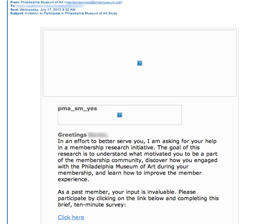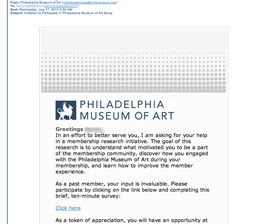Philadelphia Museum of Art Email: Is It a Work of Art?

Preview without Images

Preview with Images
Philadelphia Museum of Art Email Newsletter Grade: [B]
Subject Line | 5 |
Preview Pane | 4 |
Eye Path | 4 |
Clarity of Message | 5 |
Call to Action | 2 |
Offer | 5 |
Credibility | 5 |
Sense of Urgency | 2 |
October 17, 2013 —
Organization Overview
With a collection of over 227,000 works of art and more than 200 galleries, the Philadelphia Museum of Art is among the largest museums in the United States. The Philadelphia Museum of Art offers a wide variety of activities for public audiences, including special exhibitions, programs for children and families, films, lectures, and concerts. More than 800,000 people visit the museum’s main building each year. In addition to its landmark main building located on the west end of the Benjamin Franklin Parkway, the museum’s facilities include the Perelman Building, the Rodin Museum, and two 18th-century houses in Fairmount Park.
Strong Subject Line and Preview Pane Pique Interest
This email was sent to an individual whose annual membership at the Philadelphia Museum of Art had expired a couple of months earlier. The subject line — “Invitation to Participate in Philadelphia Museum of Art Study” — is a strong one. Instead of letting past members know that this email is a request to complete a survey, the opportunity to “participate in a study” sounds much more appealing. It helps pique readers’ interest to open the email and find out more.
The preview pane without images is also effective. Not only does it convey the main message of the email, but also the blank image space at the top encourages recipients to download the images to see what they are. The preview pane without images could be cleaner, however, by replacing the “pma-sm_yes” in the second image with more relevant alternative text.
A Rather Jarring Call-to-Action Button
Although the eye path is strong, the first call to action would be stronger with a more descriptive phrase other than “Click here.” The call-to-action button at the bottom of the email message is bright red and certainly stands out. It is rather jarring, however, especially in contrast to the subdued blue and grays used in the rest of the email. The wording on the button — “Start Survey” — is effective and drives action. At FulcrumTech, the colors used on the call-to-action button, as well as the wording of the calls to action, are variables we routinely test to help optimize our clients’ click-throughs and conversions.
Clear Message and Good Offer
The email message is clear — the museum staff wants the recipient to complete a survey to help improve “member experience.” Recipients are also told that the survey is brief and takes only 10 minutes to complete. Plus, the message ends with a subtle membership renewal reminder that says, “I hope to see you back at the Museum soon.”
The offer in this email — an incentive for completing the survey — is a good one. Recipients are told that they will be given the opportunity to enter a drawing for a $100 VISA gift card at the end of the survey. It was enough of an incentive to encourage this recipient to complete the survey.
Little Sense of Urgency, But High Credibility
Recipients are told that the winner will be notified in early August (and the email was sent mid-July). However, the survey lacks a deadline, which would help create a sense of urgency and compel more people to respond right away.
The Philadelphia Museum of Art has a history of high credibility. Having the museum’s director of membership sign the email adds even more to the overall credibility of the email message and likely helped induce even more people to convert and take the survey.
Disclaimer: FulcrumTech does not have access to the performance data relating to this promotional email, so any tests performed on this email can’t be reflected in FulcrumTech’s commentary.